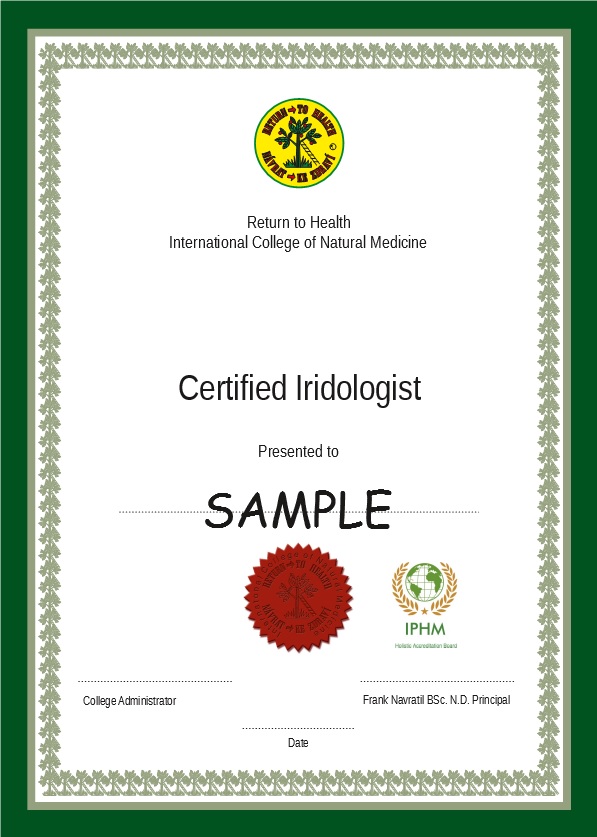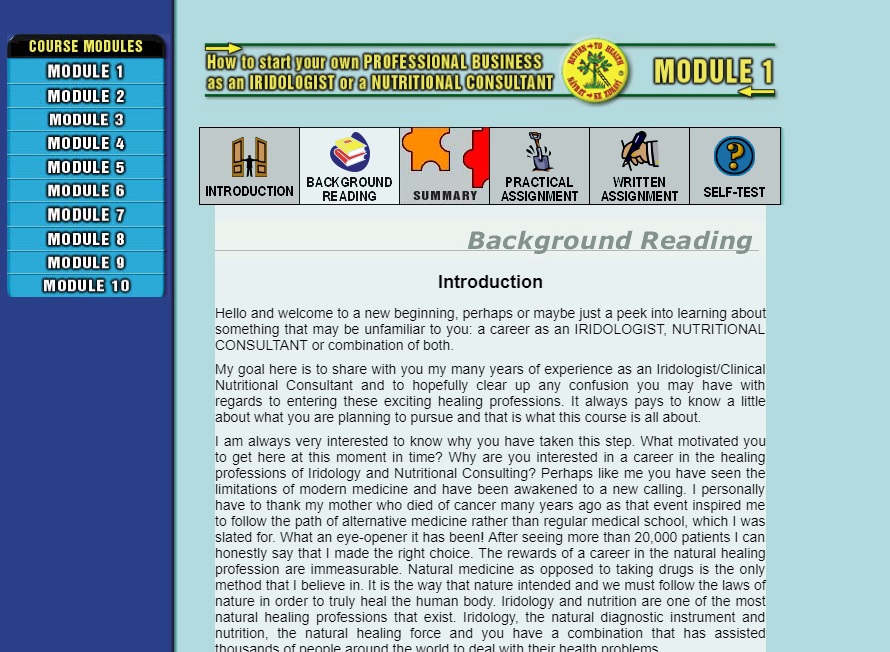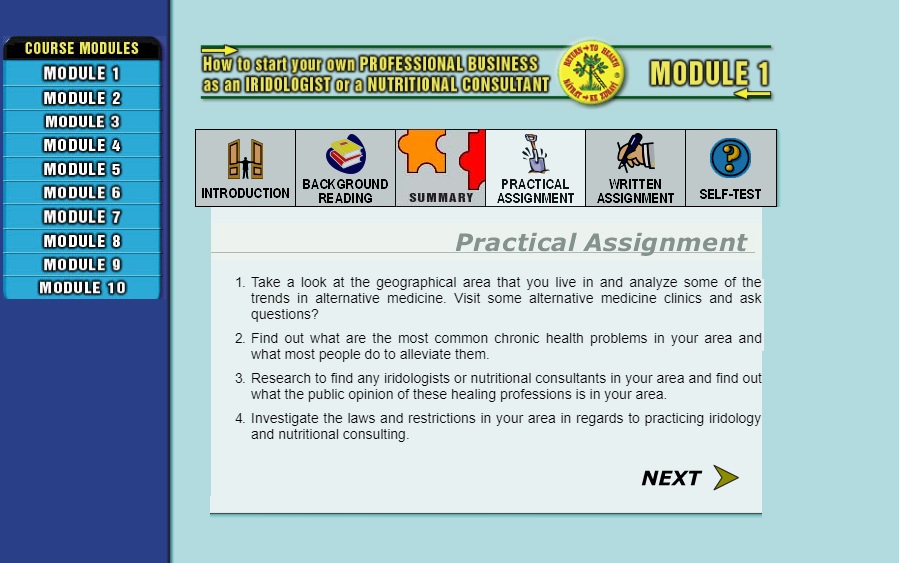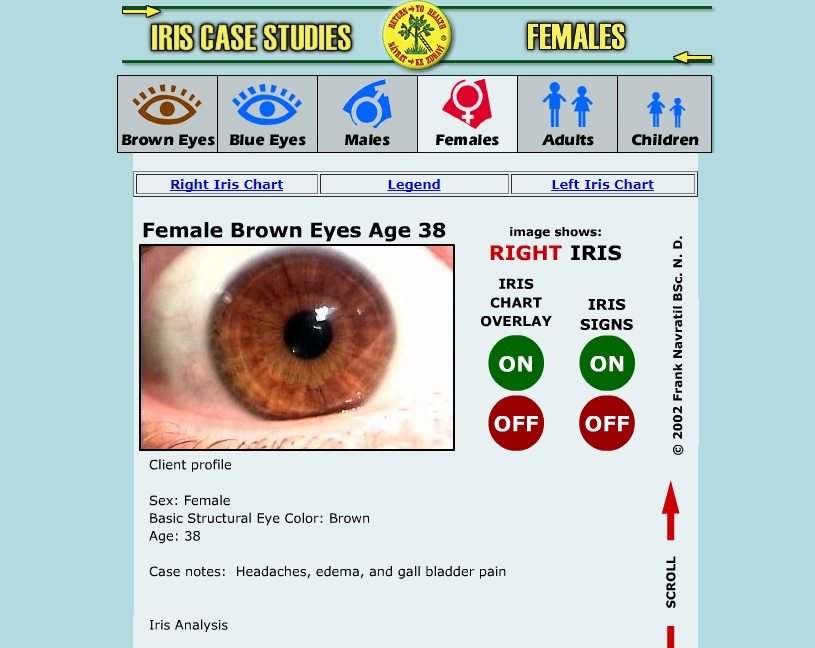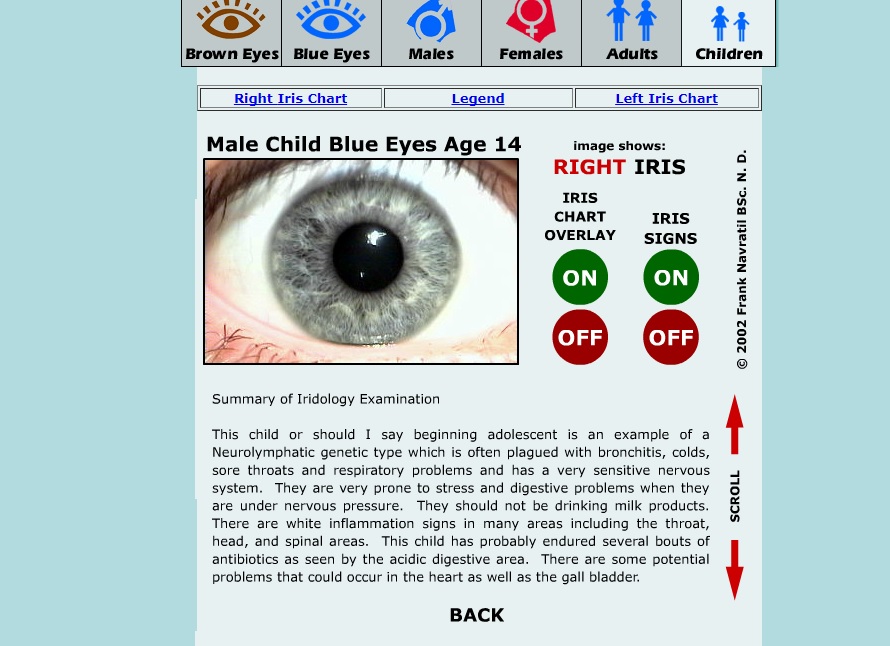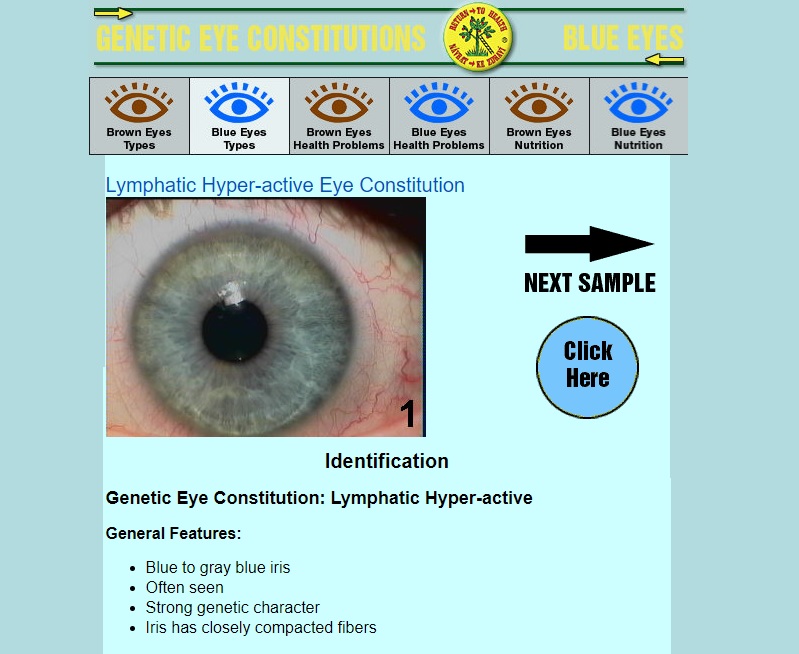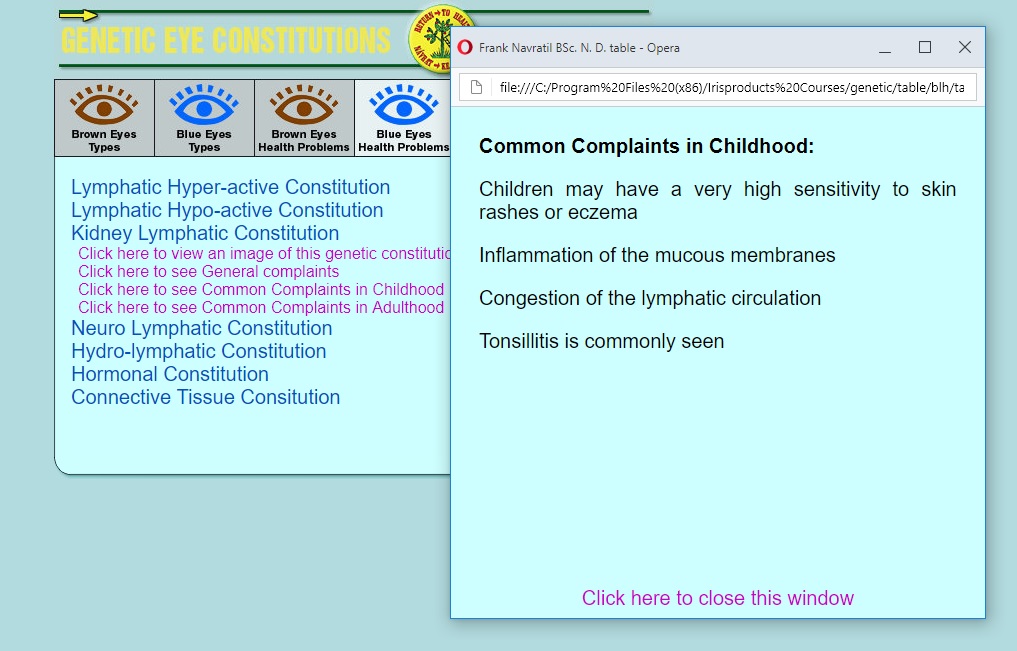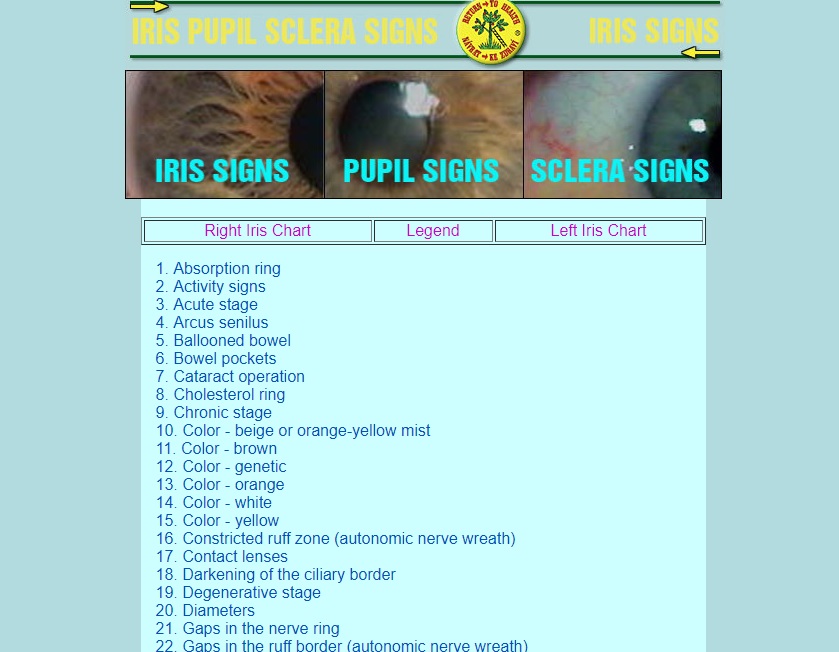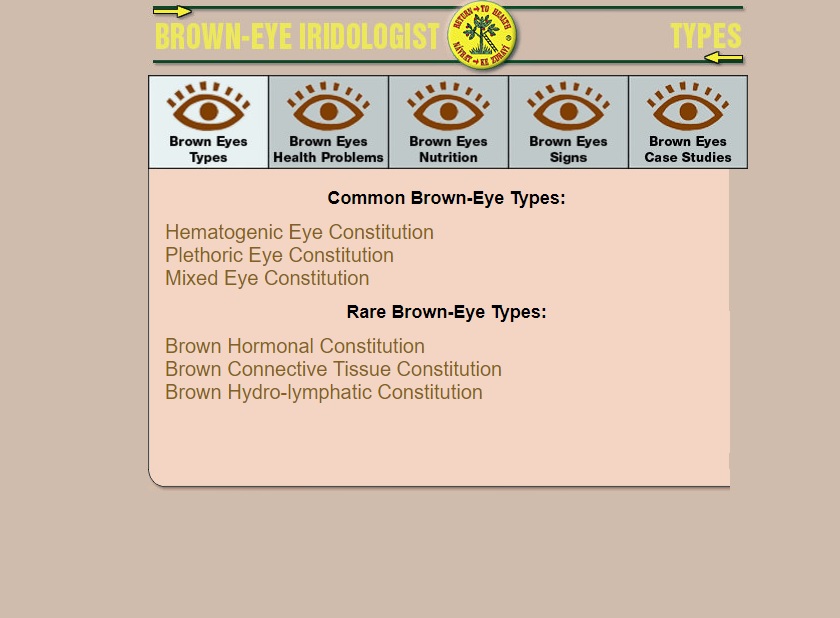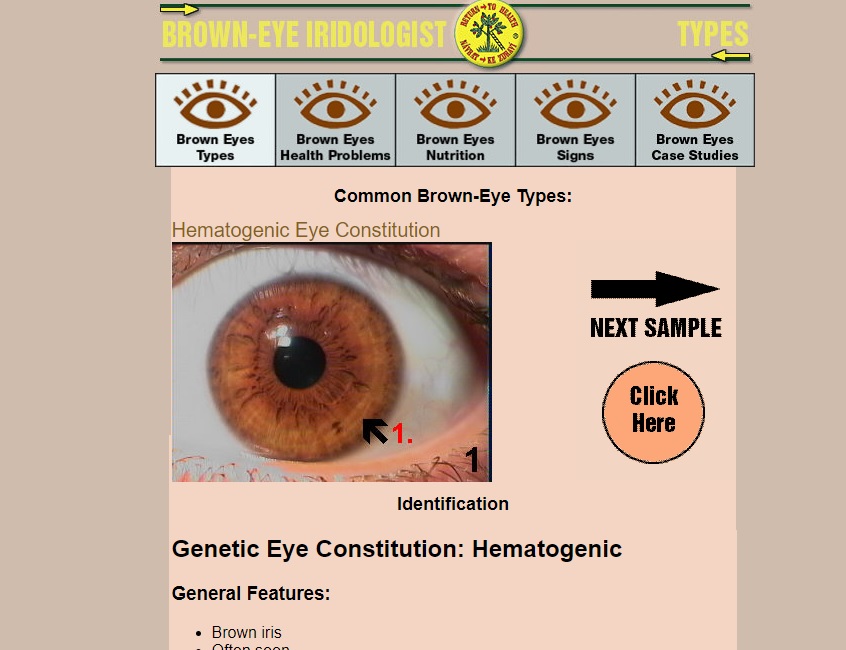
$695.00Add to cart
IRIDOLOGY COMPLETE CERTIFICATION COURSE (FOR PC/WINDOWS)
The Iridology Complete Certification Course is a series of three interactive downloadable iridology courses by Frank Navratil BSc. N.D., a world-renowned author, iridologist, naturopath, and clinical nutritionist.
- Certified Iridologist certification with International Accreditation (IPHM)
- Work at home at your own pace with no time limits
- Email your exams
- Online assistance
- Start immediately
- No prerequisites
- No experience required
- For the absolute beginner or experienced practitioner
Iridology is both an art and a science that allows one to analyze the physical and psychological health status of an individual by signs in the pupil, iris and sclera of the eye.
This set of three downloadable courses (iris 1,2 and 3) by Frank Navratil BSc. N.D, a world-renowned author, iridologist, naturopath, and clinical nutritionist, guides the beginner to advanced iridology student through step-by-step theory, practical and written assignments, color iris examples, self-tests and term exams. Whether you are a health care practitioner or just a layperson, these iridology courses allow you to learn how to easily analyze from the eyes.
Each module of each course is designed to take approximately 2 hours to complete on average although you can work entirely at your own pace and there are 10 modules for each level of each course and 3 levels all together. (Total 30 modules)
Receive a “Certified Iridologist” certificate at the end of all 3 levels after successful completion of all exams with a grade of 80 percent or more.
The Certified Iridologist course is internationally accredited with the IPHM (International Practitioners of Holistic Medicine). You can become a member of th IPHM once you complete our course. More information can be found on www.iphm.co.uk.
If you do not receive a grade of 80 percent or more on your exam result you can redo the examination as many times as you like until you achieve the required grade. There are no additional costs for iridology course examinations. End of term exams can be emailed directly online. You must successfully complete all 3 levels (Iris 1, 2 and 3) to receive a “Certified Iridologist” certificate issued by the Return to Health International College of Natural Medicine. Go back to the main menu for information about the Return to Health International College of Natural Medicine.
On-line support: for any problems or questions you may have during the course. Frank Navratil BSc. N.D. personally is available on-line to assist you during your nutrition course.
Module 1- What is Iridology?
The first module of this course is an introduction to the art and science of iridology. It includes a brief history of iridology; the concepts of individuality and holistic medicine, equipment used in iris diagnosis and the importance of treating the cause of disease not only the symptoms.
At the end of this module the student should be able to:
- explain what iridology or iris diagnosis is
- understand the concept of individuality as related to iridology
- explain the significance of holistic health
- describe the research in support of iridology
- appreciate how iridology was introduced in history
- name some of the prominent iridologists of the past
- understand the difference between treating and curing a disease
- list and explain some of the equipment used by iridologists
Module 2 – Anatomy of the Eye and Eye Diseases
The second module of this course takes a look at the anatomy of the eye, some of its functions, and common eye diseases that the iridologist often encounters.
At the end of this module the student should be able to:
- name the major structures of the eye and describe their functions
- be familiarized with common eye problems and diseases
- differentiate between signs in the iris and defects from eye injuries or operations
Module 3 – Eye Zones
The third module of the course examines the major zones that are found in the iris. It also describes how to determine a left iris from a right iris from a photograph.
At the end of this module the student should be able to:
- identify all the major iris zones
- describe what each of the major iris zones represent
- differentiate between a left and right iris and top from bottom of an iris
photograph
Module 4 – Grades of Iris Fiber Density
This module deals with how to grade an iris according to genetic density of iris fiber structure.
At the end of this module the student should be able to:
- determine the grade of iris fiber density for a given iris
- understand what is meant by each of the iris grades
- recognize the purpose of determining the iris fiber density
Module 5 – Iris Constitutions Part 1
This module is Part 1 of genetic iris constitutions. The concept of genetic constitutions is introduced as well as the factors that can weaken or strengthen your genetic make-up. The terms genotype and phenotype are explained and all the lymphatic constitutions are discussed in detail.
At the end of this module the student should be able to:
- recognize each of the 5 lymphatic-type iris constitutions and their physical iris appearance
- understand what factors can strengthen or weaken the genetic iris constitution
- differentiate between genotype and phenotype
- describe the general complaints of each genetic type
- describe the common complaints in childhood and adulthood
Module 6 – Iris Colors
This module covers the major colors that can be seen in the human iris. Similar characteristics among blue-eye and brown-eye types are discussed as well as the significance of various colors that can appear in the iris.
At the end of this module the student should be able to:
- understand the similar characteristics seen in blue or brown-eye types
- describe the main colors that appear in the human iris and their significance in iridology
Module 7 – Iris Maps
This module will introduce the iridology student to iris maps, which are used in iris diagnosis. Iris maps or charts are explained along with a brief history. An overview of the iris chart used in this course is provided.
At the end of this module the student should be able to:
- understand the significance and history of the iris map
- know the limitations and advantages of an iris map
- recognize where major organs and systems are located in the iris map provided
Module 8 – Fundamental Iridology Signs
This module introduces the beginning iridology student to some of the common signs found in the human iris and their significance.
At the end of this module the student should be able to:
- recognize some of the common iridology signs
- describe the significance of some common iridology signs
Module 9 – Fundamental Pupil and Sclera signs
This module introduces the beginning iridology student to some of the common signs found in the pupil and sclera and their significance.
At the end of this module the student should be able to:
- recognize some of the common pupil and sclera signs
- describe the significance of some common pupil and sclera signs
Module 10 – Perform your first basic iris analysis
This final module in Iris I shows the beginning iridology student how to perform a basic iris diagnosis through a logical step-by-step system. It covers the topics of safety precautions, dealing with difficult clients, and filling out a basic iris diagnosis report.
At the end of this module the student should be able to:
- understand each step in the sequence of performing an iris diagnosis
- be aware of some of the safety precautions
- be familiar with some difficulties that may arise while performing an iris diagnosis
- perform a thorough basic analysis of the irises in both eyes and come to some general conclusions
Final Term 1 Examination
This examination must be emailed online to be corrected. You must achieve a score of 80 percent before you can continue to the next course level which is Iris 2. You will be notified and if you are unsuccessful you will need to resubmit your exam. There is no limit to the amount of times that you can submit this exam. There are 50 multiple-choice questions in total and they are included at the end of your Iris 1 course. Some of the exam questions include an analysis of an iris image.
Module 1 – The 5 stages of tissue change in the iris and the Healing Crisis
The first module of Iris 2 introduces the student to tissue changes in the iris fiber structure and how to recognize these stages and what they mean to the iridologist. The concept of the healing crisis is explained as related to iridology and natural healing.
At the end of this module the student should be able to:
- define what is meant by iris tissue change
- describe the 5 stages of iris tissue change
- recognize the 5 stages of iris tissue change
- understand what the “healing crisis” is
Module 2 – Genetic Iris Constitutions – Part 2
The second module introduces the iridology student to Part 2 of the genetic iris constitutions.
The brown-eyed type of iris constitutions will be discussed here each with their different characteristics.
At the end of this module the student should be able to:
- name and describe all the major brown-eye types of genetic iris constitutions
- recognize features of each of the brown-eye types of iris constitutions
Module 3 – The Six Essential Processes of Life
This module introduces the student to the 6 essential processes of life without which one cannot achieve true healing. It prepares the iridology student for a holistic approach in diagnosis and an understanding of how systems are integrated within the human body.
At the end of this module the student should be able to:
- list and explain the six essential processes of life
- relate these processes to the study of iridology
Module 4 – Body Systems Part 1: The Digestive System and the Leaky Gut Syndrome
This module, the first of the body system modules introduces the iridology student to the digestive system. It outlines some of the digestive disorders one encounters in iridology and how they are reflected in the human iris.
At the end of this module the student should be able to:
- understand some of the functions of the human digestive system
- be familiar with the organs associated with digestion
- list some diseases associated with the digestive system
- understand factors that can affect the digestive system
- explain what the Leaky Gut syndrome is
- recognize signs in the iris related to the digestive system
Module 5 – Body Systems Part 2: Detoxification organs and Iridology
This module, the second of the Body Systems modules, introduces the student to the detoxification organs in the body.
At the end of this module the student should be able to:
- know the organs that assist the body in detoxification
- understand the basic functions of the liver, kidneys, lymphatic system and skin
- recognize some signs of the detoxification organs in the iris
Module 6 – Body Systems Part 3: The Cardio-respiratory System
This module, the third of the Body Systems modules, introduces the student to the cardio-respiratory system as it relates to iridology.
At the end of this module the student should be able to:
- understand some of the basic functions of the respiratory system and the circulatory system
- be familiar with some influences on our respiratory system and circulatory system
- recognize iris signs related to the cardio-respiratory system
Module 7 – Intermediate Iris Signs
Module 7 continues with the Iris signs in Iris 1 and introduces additional signs that can be seen in the human iris.
At the end of this module the student should be able to:
- describe each of the iris signs listed in this module and what they mean
- recognize these signs in the human iris
Module 8 – Intermediate pupil and sclera signs
Module 8 continues with the Pupil and Sclera signs in Iris 1 and introduces additional signs that can be seen in the human pupil and sclera.
At the end of this module the student should be able to:
- be familiar with the intermediate pupil and sclera signs
- recognize these signs in the human eye
- understand the implications that these signs can reveal
Module 9 – Healing Methods and Iridology
Module 9 introduces the iridology student to several healing methods that are most often used in combination with iridology. These methods are briefly explained as well as their relation to the art and science of iridology.
At the end of this module the student should be able to:
- list and briefly explain some healing methods
- explain how each of these methods can be used with iridology
- list some of the advantages and disadvantages of each method
- have a firm understanding of the meaning of nutritional therapy
Module 10 – Iris Case Studies Part 1 – The Integrated Systems Approach
The last module, Module 10 is the first of 2 parts on Iris Case Studies. The second part, Advanced Case Studies will be explained in Iris 3. This module describes in detail the case histories of 4 real patients and the signs that are evident in each of their irises. The Integrated Systems Approach to iridology is also explained.
At the end of this module the student should be able to:
- be familiar with the iris, pupil and sclera signs that are described for each case study
- recognize these signs in each client’s irises
- begin to understand how an iridologist uses a holistic approach to determine possible causes of the client’s major complaints.
- gain some practical experience in analyzing the eyes of a client, using a systematic approach and dealing with actual health problems
- understand what is meant by the Integrated Systems Approach to iridology
Final Term 2 Examination
This examination must be emailed online to be corrected. You must achieve a score of 80 percent before you can continue to the next course level which is Iris 3. You will be notified and if you are unsuccessful you will need to resubmit your exam. There is no limit to the amount of times that you can submit this exam. There are 50 multiple-choice questions in total and they are included at the end of your Iris 2 course. Some of the exam questions include an analysis of an iris image.
The Iris 3 course come complete with color iris images, iris charts, self-tests, practical assignments and the Final Course examination. It is recommended to first complete Iris 1 and Iris 2.
Module 1 – Genetic Iris Constitutions Part 3
The first module introduces the iridology student to Part 3 of the genetic iris constitutions.
The genetically weak iris constitutions will be discussed here each with their different characteristics.
At the end of this module the student should be able to:
- name and describe the weak types of genetic iris constitutions
- recognize features of each of the weak types of iris constitutions
Module 2 – Body Systems Part 4: The Hormonal System and Reproduction
This module, the fourth of the body system modules introduces the iridology student to the hormonal system and reproduction. It outlines some of the hormonal and reproductive conditions one encounters in iridology and how they are reflected in the human iris.
At the end of this module the student should be able to:
- understand some of the functions of the hormonal and reproductive system
- be familiar with each of the organs and glands associated with the hormonal and reproductive system
- list some diseases associated with the hormonal and reproductive system
- understand factors that can affect the hormonal and reproductive system
- recognize signs in the iris related to the hormonal and reproductive system
Module 3 – Body Systems Part 5: Bones and Muscles
This module, the fifth body system module, introduces the iridology student to bones and muscles. It outlines some of the functions of the skeletal and muscular systems as well as associated health conditions and how they are reflected in the human iris.
At the end of this module the student should be able to:
- list the functions of the skeletal system
- locate various sections of the spinal and muscular systems in the iris chart
- list conditions or problems related to the musculoskeletal system
- recognize muscle or skeletal signs in the iris
Module 4 – Body Systems Part 6: Sensory Organs
This module, the sixth body system module, introduces the iridology student to the sensory organs. It outlines some of the functions of the eyes, nose, ears and tongue as well as cause of associated health conditions and how they are reflected in the human iris.
At the end of this module the student should be able to:
- understand the major functions of each of the sensory organs
- locate the position of each of the sensory organs on the iridology chart
- recognize iridology signs related to the sensory organs
Module 5 – Body Systems Part 7: Psychological behavior and the Brain
This module, the last of the body system modules, introduces the iridology student to the brain and psychological behavior in iridology. It outlines some probable causes of deficiency in brain function and how physical health is related to psychological health. A number of signs that can be seen in various sectors of the brain area are described as well as those seen in the pupil border. The significance of genetic iris constitution is discussed in relation to psychological behavior.
At the end of this module the student should be able to:
- have an understanding of iridology signs found in the brain zone
- understand the relationship between physical and psychological health
- recognize signs in the iris and pupil in reference to psychological health
- recognize psychological indicators found in some genetic iris constitutional types
Module 6 – Ten Untreatable Diseases of Modern Civilization
Module 6 discusses 10 diseases of modern civilization that have not found a cure by modern medicine. Each disease is discussed in relation to possible causes that often can be revealed by studying the human iris. The Integrated Systems approach to Iridology is used in each case to find possible clues to the root of each condition.
At the end of this module the student should be able to:
- list some of the diseases that plague our modern civilization
- present possible causes for these conditions as seen through the study of iridology
- gain experience in using the Integrated Systems approach for finding probable causes
Module 7 – Iris Case Studies Part 2
Module 7 is the second of 2 parts on Iris Case Studies. The first part was explained in Iris 2. This module describes in detail the case histories of 5 real patients and the signs that are evident in each of their irises. There is a brief review on the Integrated Systems approach to iridology (discussed in Iris 2) to refresh your memory.
At the end of this module the student should be able to:
- be familiar with the iris, pupil and sclera signs that are described for each case study
- recognize these signs in each client’s irises
Module 8 – Advanced Iridology Concepts
Module 8 introduces the iridology student to advanced concepts in iridology. These include variations of signs already seen in the iris and pupil and more extensive applications in iridology.
At the end of this module the student should be able to:
- have an understanding of some advanced signs and concepts in iridology
- recognize and apply this knowledge to the analysis of the iris
Module 9 – Producing a Professional Iridology Report and Setting up a Professional Practice
In Module 9, guidelines on how to produce a professional iridology report are discussed. A sample copy of a professional iridology report is included. A list of guidelines and advice on setting up a professional practice is also included for the iridology student who would like to pursue a career in this exciting field.
At the end of this module the student should be able to:
- have an understanding of what comprises a professional iridology report
- perform an iris diagnosis and complete a professional iridology report for the client
- have an understanding of what it takes to set up a professional practice in the field of iridology
Module 10 – Review of Iris 1, 2 and 3
Module 10 is a summary overview of all the concepts introduced in each module of Iris 1, Iris 2 and Iris 3. You should be familiar with all these concepts and it is recommended that you review the relevant modules that you are unsure of before attempting the final course examination.
At the end of this module the student should:
- have a sound knowledge of all the basic concepts introduced in Iris 1, 2 and 3
- be able to use this knowledge in a practical sense to perform a complete and professional iris analysis
Final Course Examination
This examination must be emailed or sent by post to be corrected. You must achieve a score of 80 percent or more to receive a “Certified Iridologist” certificate. Prior to this you must have successfully completed Iris 1 and Iris 2. It is not possible to submit your final course examination if the prior has not been completed.
This certificate will be mailed to your address. You will be notified if you are unsuccessful after which you will need to resubmit your exam. There is no limit to the amount of times that you can apply for the certificate. There are 100 multiple-choice questions and they are included at the end of Iris 3. Most of the exam questions include an analysis of an iris image.

$149.00Add to cart
How to start a business in Iridology or Nutritional Consulting (for PC/Windows)
By world-renowned iridologist, clinical nutritionist, author and naturopathic doctor, Frank Navratil BSc. N.D.
Do you have the desire to start your own business in the exciting natural therapies field? Have you ever wondered what it takes to start a practice in iridology or nutritional therapy or are you already in the field and want to improve your existing business?
Finally, the first downloadable course of its kind that guides you from the very beginning on what it takes to start your own business as an iridologist or nutritional consultant.
Written by Frank Navratil BSc. N.D. a world-renowned iridologist and nutritional consultant from his many years of running a successful practice in this field.
A high percentage of natural therapy businesses fail within the first year. Dont let it happen to you and ensure that you have the best chance for success.
The How to start your own professional business as an iridologist or nutritional consultant, home-study course is an interactive educational tool that is easy to follow so that anyone can learn how to go about starting a practice in this rapidly growing field of natural medicine. This is a self-study resource course. There are no exams to send in, and no certificates issued for this course.
The course consists of 10 modules each with background reading material, written and practical assignments and interactive self-correcting tests.
Whether you are contemplating a career in iridology or nutrition or whether you are already working in the field, this resource is full of useful advice on all aspects of running a successful natural health care practice.
We hope that you learn, enjoy and uncover some useful information that will assist you in developing a successful and professional iridology or nutritional consulting business.
Module 1: WHY CHOOSE IRIDOLOGY OR NUTRITION AS A CAREER?
The first module of this course examines the advantages of a career in iridology or nutritional consulting. It includes a brief overview of the trends in alternative health care, what iridology and nutritonal consulting is all about, the rewards of these healing professions, the important concept of holistic health and what is meant by the iridology-nutrition connection. Included is also an examination of what it takes to enter this profession, barriers that one commonly encounters and attributes for success in this exciting field of natural medicine.
At the end of this module the student should be able to:
- comprehend some trends that are occuring in alternative health care
- understand the difference between conventional medicine and alternative medicine
- be familiar with some statistics in our modern health care system
- explain what is meant by iridology and nutritional consulting
- explain the concept of holistic health
- understand what is meant by the iridology-nutrition connection
- appreciate what is required to be a professional iridologist or nutritional consultant
- appreciate the rewards of a career in the healing profession
- describe barriers that one often encounters in the alternative healing profession
Module 2: SETTING UP AN IRIDOLOGY OR NUTRITIONAL CONSULTING PRACTICE
The second module of this course examines the first steps in setting up an iridology or nutritional consulting practice. It includes naming your business and developing a logo, determining your mission statement and setting goals and objectives, financial planning, record keeping, locating your business premises and analyzing your competition.
At the end of this module the student should be able to:
- understand the importance of a business name and company logo
- be familiar with business planning by determining a mission statement, goals and objectives
- be familiar with some statistics in our modern health care system
- make a financial plan related to running an iridology or nutritional consulting practice
- understand what is required for record-keeping
- recognize the importance of analyzing your competition
- appreciate what is required for choosing your business premises
Module 3: EQUIPMENT RECOMMENDED FOR YOUR IRIDOLOGY OR NUTRITIONAL CONSULTING PRACTICE
The third module of this course examines some equipment that is recommended to run a professional iridology or nutritional consulting practice. It includes an explanation of a variety of tools that the iridologist or nutritional consultant uses in the course of daily practice. A discussion of profesional iridology equipment and nutritional products is also included.
At the end of this module the student should be able to:
- be familiar with various tools that the iridologist or nutritional consultant uses in daily practice
- to be aware of what professional iridology equipment is available
- appreciate the role of nutritional products
Module 4: MARKETING YOUR IRIDOLOGY OR NUTRITIONAL CONSULTING PRACTICE
The fourth module of this course examines the use of marketing techniques to promote your iridology or nutritional consulting practice. It includes basic marketing research techniques, development of your service, promotion strategies and pricing. Topics discussed also include finding the right location for your premises, learning from your competition and building a solid client base.
At the end of this module the student should be able to:
- be familiar with various marketing research techniques
- able to identify what your service to your clients will be
- understand various methods used to promote a practice
- know how to effectively price your service
- appreciate the importance of location of your premises
- understand what you can learn from your competition
- identify ways to build a solid client base
Module 5: DEVELOPING YOUR CREDIBILITY AS A PROFESSIONAL IRIDOLOGIST OR NUTRITIONAL CONSULTANT
The fifth module of this course examines techniques that will develop your credibility as a professional iridologist or nutritional consultant. It includes a discussion of interpersonal skills, professonal behavior, confidentiality and lecturing. Included are methods that will build your reputation and professionalism in the field of iridology or nutritional consulting.
At the end of this module the student should be able to:
- list the factors that are important to develop credibility and professionalism
- appreciate the meaning of professional behavior
- appreciate the value of education
- be familiar with important interpersonal skills
- appreciate the value of publishing articles and writing
- understand the benefits of effective lecturing and presentations
Module 6: MORAL, ETHICAL AND LEGAL ISSUES THAT ARISE IN AN IRIDOLOGY OR NUTRITIONAL CONSULTING PRACTICE
The sixth module of this course examines moral, ethical and legal issues related to an iridology or nutritional consulting practice.
At the end of this module the student should be able to:
- Discuss the esssential components of professional ethics
- Be familiar with moral questions that can arise in a clinical setting
- Recognize some of the main moral issues that can confront the practitioner
- Recognize the legal implications for an iridologist or nutritional consultant in diagnosing and treating health problems
Module 7: PROFESSIONAL IRIDOLOGY AND NUTRITIONAL REPORTS
The seventh module of this course examines reports related to a professional iridology or nutritional consulting practice.
At the end of this module the student should be able to:
- Be familiar with the esssential components of a professsional iridology report
- Be familiar with the essential components of a professional nutritional report
Module 8: THE IRIDOLOGY OR NUTRITIONAL CONSULTATION
The eighth module of this course examines what is involved in an iridology or nutritional consultation, as well as the client-consultant relationship.
At the end of this module the student should be able to:
- Appreciate what clients expect from an iridology or nutritional consultation
- Understand some important components in developing a client-consultant relationship
- Be familiar with ways in which to reduce fear or anxiety during the consultation
- See the importance of developing active listening skills
- Understand the need and role of feedback and follow-up
Module 9: CONTINUING EDUCATION FOR THE IRIDOLOGIST OR NUTRITIONAL CONSULTANT
The ninth module of this course examines educational requirements and recommended continuing education for the professional iridologist and nutritional consultant.
At the end of this module the student should be able to:
- Understand the recommended educational requirements to be an iridologist or nutritional consultant
- Appreciate the value of continuing education
- Be familiar with a variety of iridology and nutrition educational resources
Module 10: ESSENTIAL ADVICE FROM FRANK NAVRATIL BSC. N.D.
The tenth and last module of this course includes advice from Frank Navratil BSc. N.D., world-renowned iridologist, naturopathic doctor and natural health book writer to those wishing to pursue a career in iridology or nutrition.
At the end of this module the student should be able to:
- Appreciate early humble beginnings
- Understand how honesty, belief and hard work paves the way to success
- Recognize how natural medicine has a promising future
- Learn how to keep motivated and overcome barriers
- Appreciate the importance of caring for yourself to avoid burn-out
- Discover how to find the role and path in life
- Be now equipped to start on the road to establishing their own professional iridology or nutritional consulting practice

$149.00Add to cart
100 Iris Case Studies (for PC/Windows)
“For Your Eyes Only” Iris Case Studies is an interactive resource and an Iridology educational tool developed by world renowned iridologist, naturopath and clinical nutritionist Frank Navratil BSc. N.D. It is one of the most advanced studies of actual cases ever to be compiled.
Whether you have completed the Iridology Complete Certified Course or whether you are a practicing iridologist or student, you will find 100 Iris Case Studies to be an enormous additional resource tool to gain experience with real-life health problems and their causes.
Dr. Frank Navratil has put together 100 interactive case studies from real-life cases of men, women and children analyzed over many years from his successful European Naturopathic practice. It includes patients who have diseases like cancer, diabetes, eczema, digestive problems, migraines, high blood pressure, allergies, arthritis, asthma, and many others. This one of a kind downloadable resource includes 200 iris photographs of the left and right irises of 100 real-life case studies.
The iris case studies have been conveniently grouped together under the categories of Blue Eyes, Brown Eyes, Male, Female and Children. Each case study has been identified whether it is Male or Female, a blue eye or brown eye type, as well as the age of the client. For example: Male Blue Eyes Age 50
When you click on any of the case studies a display panel will appear which will include images of the client’s right and left eye, as well as written information on the client profile, genetic constitution, iris signs in the right and left eye, and a summary of the Iridology examination.
This interactive learning tool allows you with the touch of a button to overlay an iridology chart on every right and left iris or to display iridology signs labeled on each iris. This allows you to not only see what iridology signs are present but also in what sector of the iris they are located. You can also opt to enlarge or zoom into the iris image.
LEARN ABOUT REAL-LIFE IRIDOLOGY CASE STUDIES EASILY AT HOME AND AT YOUR OWN PACE
EXPAND YOUR KNOWLEDGE IN IRIDOLOGY

$149.00Add to cart
GENETIC EYE CONSTITUTIONS (FOR PC/WINDOWS)
“For Your Eyes Only” Genetic Eye Constitutions is an interactive resource and an Iridology educational tool developed by world-renowned iridologist naturopath and clinical nutritionist Frank Navratil BSc. N.D. It includes research from real-life patient studies over many years from his successful European Naturopathic practice in an easy to follow interactive format. It is one of the most advanced studies of genetic eye constitutions ever to be compiled. Whether you have completed the Iridology Complete Certification Course, or whether you are a practicing iridologist, nutritionist or student, you will find Genetic Eye Constitutions to be an excellent resource to gain experience with identifying genetic eye constitutions, their health problems and their nutritional needs.
The Genetic Eye Constitutions include all the major blue-eye and brown-eye types found around the world and offers identification of each of these types with common features and constitution signs, related health problems, and nutrition and lifestyle advice. Included are over a 100 samples of iris images many of which are labeled, identifying common constitutional signs. General features of each constitution are clearly explained so that even the beginner can learn to accurately identify each of the genetic types and to learn to prescribe specific nutritional therapy and lifestyle advice.
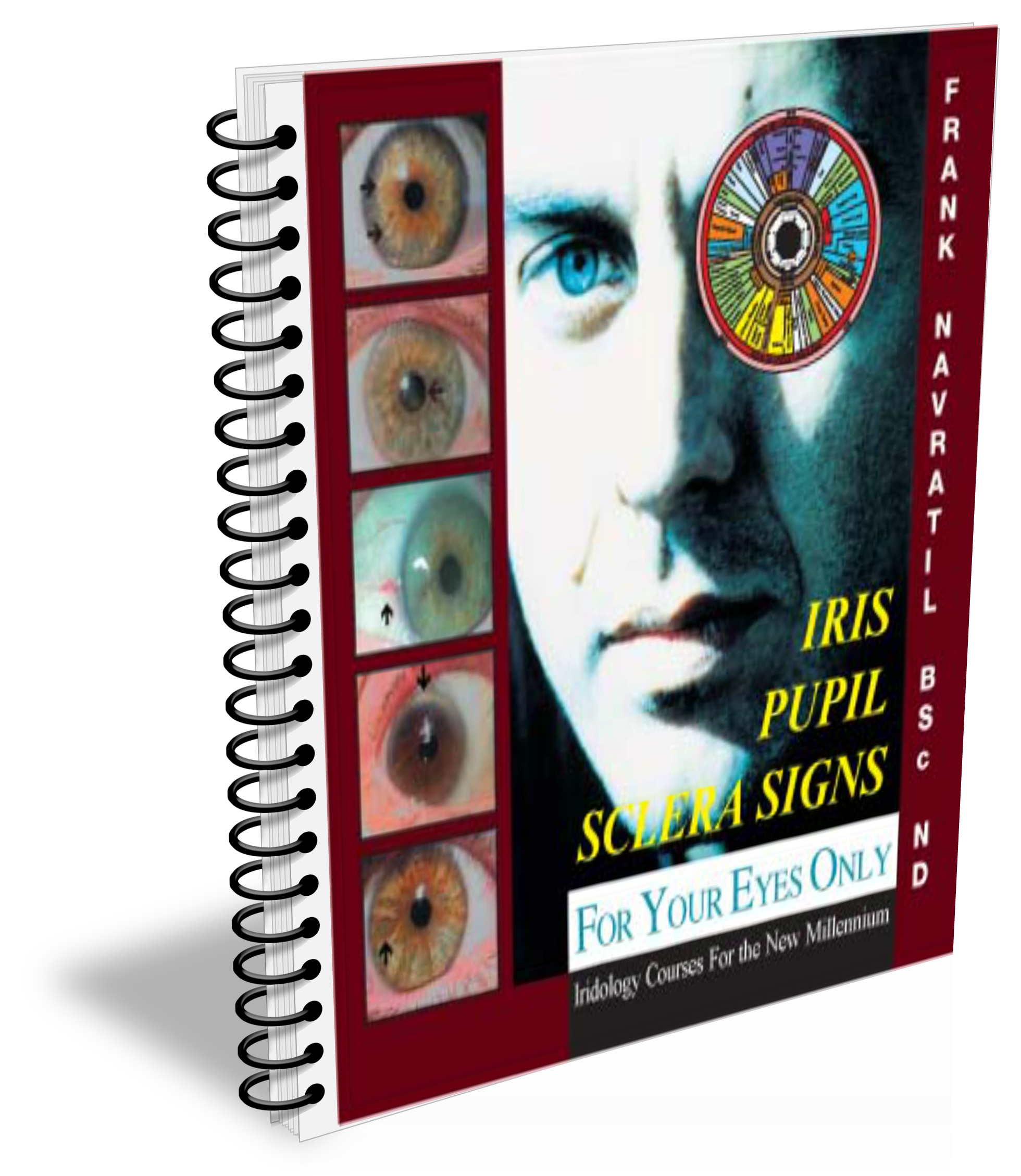
$149.00Add to cart
IRIS,PUPIL,SCLERA SIGNS (FOR PC/WINDOWS)
“For Your Eyes Only” Iris, Pupil and Sclera Signs is an interactive and an Iridology educational tool developed by world-renowned iridologist, naturopath and clinical nutritionist Frank Navratil BSc. N.D. It includes research from real-life patient studies over many years from his successful European Naturopathic practice in an easy to follow interactive format. It is one of the best collections of iris, pupil and sclera signs found in a comprehensive downloadable resource.
Includes:
- Cardiac signs
- Digestive problem signs
- Pancreas signs
- Urogenital signs
- Thyroid signs
- Liver signs
- Kidney signs
- Skin signs
- Nervous system signs
- Genetic signs
- Hormonal signs
- Lymphatic system signs
- Circulatory signs
- Lacuna types
- Iris pigments and colors
Iris, Pupil, Sclera Signs offers identification of each of these signs using well over a hundred real-life labeled iris images with clear explanations for each.
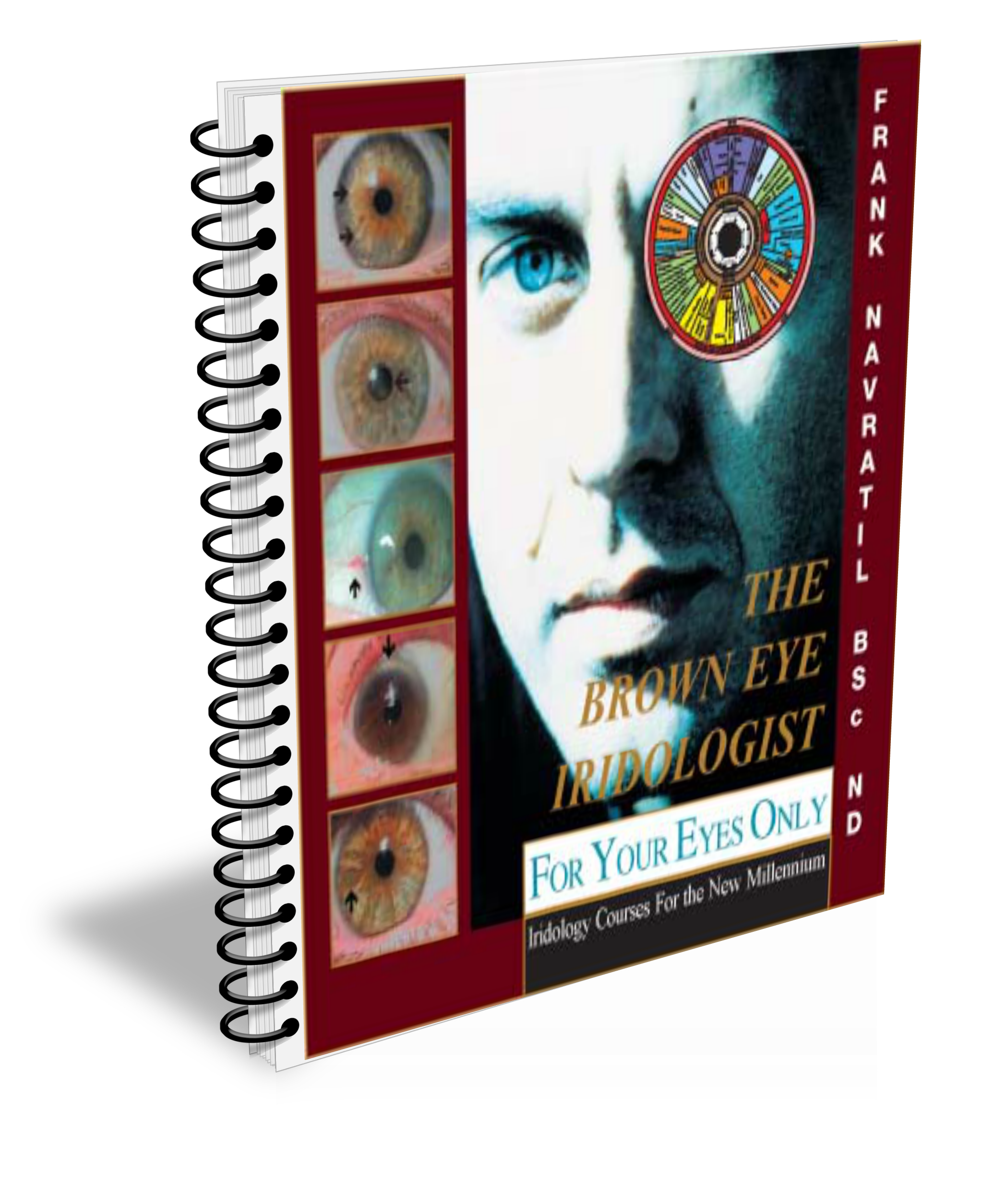
$149.00Add to cart
BROWN EYE IRIDOLOGIST (FOR PC/WINDOWS)
The “For Your Eyes Only” Brown-Eye Iridologist is an interactive downloadable resource and an Iridology educational tool developed by world – renowned iridologist, naturopath and clinical nutritionist Frank Navratil BSc. N.D. It includes research from real-life brown-eye patient studies over many years from his successful European Naturopathic practice in an easy to follow interactive format. It is one of the most advanced studies of brown eyes ever to be compiled.
Whether you are a practicing iridologist, nutritionist, health professional or student, you will find the Brown Eye Iridologist an enormous additional resource tool to gain experience with identifying brown-eye constitutions, their health problems, nutritional needs, signs specific to the brown iris and sclera as well as learning through real-life brown-eye case studies.
This resource has been designed for those who would like to learn all about the human brown iris and especially for those living in areas of the world where brown-eye types predominate.
The Brown-Eye Iridologist includes all the most common brown-eye types as well as the rare types found around the world and offers identification of each of these types with common features and constitution signs, related health problems, and nutrition and lifestyle advice. Included are over 130 samples of brown iris images many of which are labeled, identifying common signs and specific information related to the brown iris. General features of each brown-eye constitution are clearly explained so that even the beginner can learn to accurately identify each of the genetic types and to learn to prescribe specific nutritional therapy and lifestyle advice. Also included are 38 brown-eye case studies with images of both right and left irises, interactive iris chart overlays and iris signs, taken over many years from the naturopathic clinic of Dr. Frank Navratil. These brown-eye case studies include male, female and child patients with a variety of diseases including cancer, diabetes, liver and gallbladder disease, digestive problems, eczema, mononucleosis, high cholesterol, arteriosclerosis and heart problems, allergies, asthma and many others. Often a very difficult iris to analyze, the brown iris has never before been so easy to learn and so clearly explained.






